Some of Australia top architects’ best work is in small spaces flush with success:the public amenity block.
“As far as we are concerned,it is the smallest civic building,and it should be treated like that,” said Andrew Nimmo,a former president of the NSW chapter of the Australian Institute of Architects,whose practice,Lahznimmo,has won a range of architecture awards for its light and airy loos.
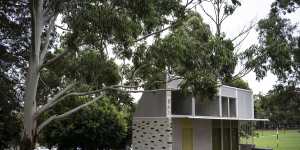
The new toilet block in Camperdown Memorial Park. Designed by Lahznimmo architects it is one of three amenity blocks shortlisted for an architecture award by the NSW Chapter of the Institute of Architects.Wolter Peeters
Designing and building a public toilet block to last as long as an old-fashioned pissoir can take years of negotiation with councils and locals,alive and dead.
They’re also expensive. And Nimmo,working with newly registered architects Patrick Love and Luke Walker,also had to avoid old graves that lay under the site for the toilet block in Sydney’s historic Camperdown Memorial Rest Park. “On a per-square-metre basis,the[amenities block] is one of the most expensive public buildings. If you try to do it cheaper,it is almost impossible. It involves plumbing,and in our case,an archeologist,to avoid the graves,” said Nimmo.
The Camperdown toilets are one of three public amenity blocks that have been shortlisted for this year’s NSW architecture awards. The others are Parry Park pavilions in Lakemba by Archrival (Custom Mad and Lucy Humphrey Studio) with Lucy Simpson (Gaawaa Miyay) and Copy Nature Office,and Mona Vale beach amenities and lifeguard facility by Warren and Mahoney.
They’ll be judged with the same seriousness as other entries on the shortlist,including the new wing of the Art Gallery of NSW,schools and homes.
Nimmo and Annabel Lahz,his partner in life and architecture,share the city’s throne as the reigning king and queen of the modern toilet block.
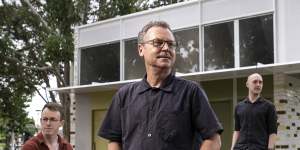
Architects Patrick Love,Andrew Nimmo and Luke Walker at their newly finished toilet block in Camperdown.Wolter Peeters
Their award-winning set of five toilet blocks in Centennial Park in 2006 was the first to move the basins outside and into the open,and bring light and ventilation inside.
“Public toilets were nasty things,and you built them as cheaply as you could,and built them like a bomb shelter,” said Nimmo. “When we did Centennial Park it showed everyone they can be nice piece of architecture,and have a role beyond being a toilet.”
Lahz said they needed natural light,and lots of good natural ventilation:“You can’t have too much.”
Their designs galvanised councils and inspired other architects to build a new generation of loos with outdoor benches and basins,often overlooking trees or gardens,dog bowls,and awnings to gather if it rained.
Importantly,they eliminated nasty dark corners,so parents could keep an eye on their children.
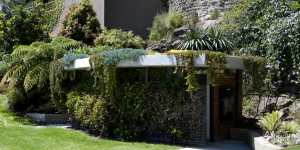
The toilet block at Beare Park,Elizabeth Bay,was updated by Sam Crawford Architects. Paul Patterson
Toilets were called once brick shithouses for a reason,says Sydney architect Sam Crawford. He’s designed 16 blocks,including three yet to be completed,across Sydney from Queens Park to Dolls Point,Kyeemagh and Glebe.
“The term brings to mind a smelly,dank,dark place,” said Crawford.
“We are flipping the idea of the toilet,which used to be shameful. We are trying to bring joy into these buildings,and daylight,so they are well-lit,safe and have a sense of being cared about.”
Crawford’s award-winning amenities block at North Bondi has a green roof,playful skylights and polished concrete to withstand sand and salt.
Many emerging architects have field-tested ideas,and won bigger projects,by building these public conveniences.
Highly decorated architects Durbach Block Jaggers won the 1999 competition to design the Olympic Park Amenities building,and are now part of the team behind Powerhouse Ultimo’s renewal.
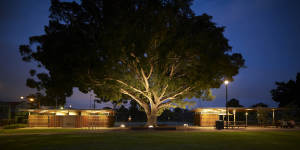
A giant fig tree stands between two facilities blocks at Turruwul Park in Rosebery designed by HASSELL with City Projects,City of Sydney.Brett Boardman
At Camperdown,new graduates Love and Walker were entrusted with the design of the project from beginning to end,with Lahz and Nimmo overseeing.
“They have to take everything the world can throw at them,” said Love. Within a few hours of completion,the new block had been tagged with graffiti,which was quickly removed.
Sydney’s Lord Mayor Clover Moore said not every toilet block could be grand or award-winning,but they were all important.
Council had “gone to great lengths” recently to design the new amenity blocks at Pirrama Park in Pyrmont to create a template for high-quality design that minimised costs and made maintenance easier.
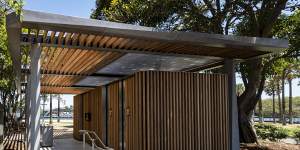
The new facilities at Pirrama Park in Pyrmont.Paul Patterson
Council was also installing “thoughtfully” designed automated public toilets on streets to improve the public’s access to toilets.
Before Steven Fighera of Chrofi designed his first block he visited Lahznimmo’s blocks in Centennial Park.
By bringing the basins outside,he said,it became an opportunity for these facilities to become more than a toilet block. “It does become a place where people can hang out.”
In Maitland,Fighera said what started as a design for a “humble toilet block” project expanded into a public plaza with a cafe on the banks of the Hunter River.
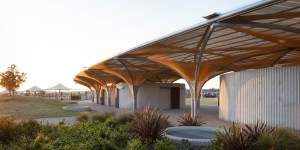
The public amenities at Elara Sporting Fields by Chrofi architects in Marsden Park.Clinton Weaver
Chrofi,working with McGregor Coxall,won three of the most prestigious awards in 2019:The NSW Architecture Medallion,the Sulman Medal for Public Architecture,and the Blacket Prize.
Andrew Stanic of Stanic Harding,another award winner,recalled going to stinky,dark and grim toilets as a child. “You don’t realise how important surveillance is. Little kids also need to feel safe when they go to the loo.”
Often a public toilet may be the first thing that someone new to a place sees and wants. That was the case in the Blue Mountains,where many domestic and foreign tourists hopped in a bus from the city to visit the World Heritage site,only to stop at an old brick toilet.
Not very Instagrammable at all.
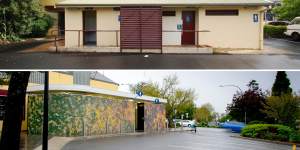
Before and after:The public toilet block in Leura. New block by Welsh + Major.Supplied/Ben Guthrie
David Welsh,of Welsh + Major,who designed Leura’s new toilets,said in the past there would be 60 people lining up busting to go waiting for loos.
His practice was commissioned to build a bigger and more pleasant ablutions block off the Leura Mall,which is tiled in the colours of the autumnal leaves.
The Morning Edition newsletter is our guide to the day’s most important and interesting stories,analysis and insights.